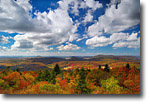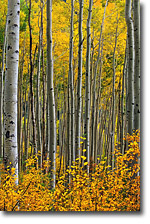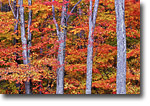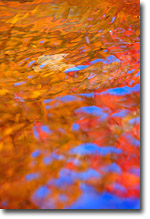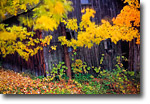1. The Right Place At The Right Time
This may sound quite obvious, but being in the right location when the color is at or near peak is essential in coming back with the great autumn images. No matter where you are shooting, there is bound to be a website or fall color hotline with foliage updates and weather reports. When I am planning a trip I always begin checking the color forecast about 3 weeks in advance. I like to look at the progression of color and weather patterns to have an idea of where and what I will shoot when I get on location.
|
2. Let It Rain, Let It Rain, Let It Rain
Bad weather means great conditions for landscape and nature photography. Other than at sunrise or sunset, I am almost always wishing for the soft light of an overcast day. Sprinkle in a little mist, fog or light rain and you have yourself the perfect conditions for shooting autumn color. Remember not to include the sky in your compositions, as it will be recorded as white and without any texture or detail, sucking the viewerís attention away from your intended focal point. When its overcast and wet I am often drawn to shooting waterfalls and stream scenes, but nice tight frame filling compositions of trees and mount sides are also perfect subject matter for these conditions. If itís raining heavy, wait it out until the rain subsides. If youíre going to be out in the elements remember to protect your gear with a rain cover or attach an umbrella to the tripod. Be sure to check the front element of your lens for rouge raindrops and condensation and always carry some towels for wiping down your wet gear.
3. Juxtapose Colors
The use of complimentary colors should always been in the back of a nature photographerís mind. Whether youíre shooting in summer, winter or fall, the juxtaposition of complimentary colors will make your images stronger and more visually appealing. Red foliage against an azure blue sky, yellow reflections and soft blue casts under shade, green foliage mixed in with reds, purples and yellow shades of autumn trees all work well. The combinations are endless. Look for color and then try to find its compliment to juxtapose and you are on your way to creating dynamic autumn images.
4. Let It Blow, Flow And Toss
Donít shy away from shooting on windy days. With your camera firmly mounted on a tripod, use a long shutter speed by stopping your lens down or using neutral density filters to let foliage blur and take on a painterly look. Be sure to anchor the image by placing a tree trunk, barn, or rocks in the composition to contrast the blurred effect of the blowing leaves and foliage.
5. Reflecting Rainbows
I love to photograph reflections and I am always on the lookout for calm bodies of water with mirror images of the landscape. Early morning and late afternoon are the very best times for catching these reflections. Itís best to have the body of water in shade and the reflected subject in warm, angled light. Reflections go beyond the typical water shots and are often very nice in small streams and rivers. Once again, I look for a bank of colorful trees to be illuminated by the early morning or late afternoon sun and dynamic section of cascades or waterfalls that are shaded. I like to keep my cameraís white balance set to daylight in order to allow blue sky reflections to contrast with the warm colors of the foliage.
6. Keep The Compositions Simple
Simple and clean compositions work best for showcasing autumn colors. Shooting autumn foliage can be a visual overload and you may be tempted to try and include as much in the scene as possible. Stick with two or three key picture elements and crop out anything that competes with the main subject of the shot. Remember to use power shapes and strong graphic lines to direct the viewer into and through the composition, making sure the eye lands at all of the most interesting spots.
7. Filters For effect
There are a few filters that will help you capture the best possible colors during the autumn season. I keep a circular polarizer, Vari-ND, Color Combo and a set ND grad filters in the bag whenever I am out in the field shooting fall foliage. The circular polarizer is essential for removing unwanted glare from the surface of wet leaves and rocks as well as darkening those dramatic skies at sunrise and sunset. I will often pull out the Singh Ray Vari-ND when I need to increase my exposure for creative effects. Its great for capturing long exposures of moving clouds, wind tossed foliage, and cotton candy waterfalls. The color combo is one that I will use on occasion to really pump up the reds, greens and blues in my shots. Itís been in my bag since the days of film and I still use it today with digital. The Singh Ray Color Combo has the additional benefit of being a circular polarizer as well. And last but not least, I always have my Graduated Neutral Density filters on hand for balancing extreme contrast at sunrise, sunset or any high-key lighting situation. My favorite grad filters are the Singh Ray 4x6 in 2- and 3-stop hard and 4 stops soft.
8. Get Intimate With Telephotos and Macro
Intimate autumn scenes are very powerful, in my opinion, and should not be overlooked. Remember to always look down at your feet when shooting. Some of the best shots are often just beneath us. Early in the morning is a great time to shoot dew drops, macro images of autumn leaves, spider webs and much more. Your local meadow or park will do just fine for finding awesome macro images. I like to use a 105mm Macro lens and set of extension tubes for my 80-200mm and 300mm to capture my autumn close ups. For the intimate landscape, a mid-range telephoto lens will work best and allow you to really focus in on the patterns and details in the larger scene. Look for repeating shapes and patterns in the landscape and focus in on them for dynamic natural images.
Here are a few resources I have very helpful for tracking autumn color:
The Foliage Network - http://www.foliagenetwork.net
Vermont Color Reports - http://www.vtonly.com/foliage.htm
National Forest Service - http://www.fs.fed.us/news/fallcolors
Weather.com Fall Color Reports - http://www.weather.com/activities/driving/fallfoliage/?from=secondarynav
Comments on NPN landscape photography articles? Send them to the editor.
Joseph Rossbach is a professional landscape and nature photographer based out of Annapolis, Maryland. Over the past ten years, he has traveled into some of the most beautiful and remote areas of the United States in order to capture the American landscape. His images have appeared in local and regional magazines, calenders, advertising campaigns, websites and in books and art galleries and corporate collections. Joe is a Mountain Trail Photo team member and leads through Mountain Trail Photography Workshops. To see more of Joseph's images visit his website at www.josephrossbach.com.
